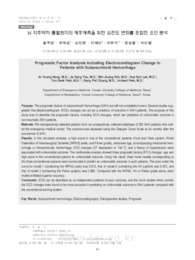

PARTNER
검증된 파트너 제휴사 자료
뇌 지주막하 출혈환자의 예후예측을 위한 심전도 변화를 포함한 요인 분석 (Prognostic Factor Analysis Including Electrocardiogram Change in Patients with Subarachnoid Hemorrhage)
9 페이지
최초등록일 2025.04.01
최종저작일
2017.02

-
미리보기
서지정보
· 발행기관 : 대한응급의학회
· 수록지 정보 : 대한응급의학회지 / 28권 / 1호 / 62 ~ 70페이지
· 저자명 : 홍주영, 유제성, 김민정, 이혜선, 정성필, 박인철, 박유석
초록
Purpose: The prognostic factors of subarachnoid hemorrhage (SAH) are still not completely known. Several studies suggested that electrocardiogram (ECG) changes can act as a predictor of outcome in SAH patients. The purpose of this study was to describe the prognostic factors, including ECG changes, which are predictive of unfavorable outcome in non-traumatic SAH patients.
Methods: We retrospectively selected patients from our prospectively collected database of 202 SAH patients who visited the emergency medical center. The outcome was assessed using the Glasgow Coma Scale at six months after the occurrence of SAH.
Results: In the univariate analysis, a high score in one of the conventional systems (Hunt and Hess system, World Federation of Neurosurgical Societies [WFNS] scale, and Fisher grade), advanced age, accompanying intracranial hemorrhage or intraventricular hemorrhage, ECG changes (ST depression or Tall T), and a history of hypertension were associated with unfavorable outcome. The multivariate analysis showed three prognostic factors (ECG changes, age and high score in the conventional system) for unfavorable outcome. Using this result, three novel models corresponding to the three conventional systems were constructed to predict an unfavorable outcome in such patients. The area under the curve for model 1 (containing the WFNS scale) was 0.912, that of model 2 (containing the HH system) was 0.913, and that of model 3 (containing the Fisher system) was 0.885. Compared with the WFNS, HH or Fisher grade alone, each model exhibited superior accuracy.
Conclusion: ECG can be described as an independent predictor of poor outcome, and the novel models which contain the ECG changes were found to be more accurate in predicting an unfavorable outcome in SAH patients compared with the conventional scoring system.영어초록
Purpose: The prognostic factors of subarachnoid hemorrhage (SAH) are still not completely known. Several studies suggested that electrocardiogram (ECG) changes can act as a predictor of outcome in SAH patients. The purpose of this study was to describe the prognostic factors, including ECG changes, which are predictive of unfavorable outcome in non-traumatic SAH patients.
Methods: We retrospectively selected patients from our prospectively collected database of 202 SAH patients who visited the emergency medical center. The outcome was assessed using the Glasgow Coma Scale at six months after the occurrence of SAH.
Results: In the univariate analysis, a high score in one of the conventional systems (Hunt and Hess system, World Federation of Neurosurgical Societies [WFNS] scale, and Fisher grade), advanced age, accompanying intracranial hemorrhage or intraventricular hemorrhage, ECG changes (ST depression or Tall T), and a history of hypertension were associated with unfavorable outcome. The multivariate analysis showed three prognostic factors (ECG changes, age and high score in the conventional system) for unfavorable outcome. Using this result, three novel models corresponding to the three conventional systems were constructed to predict an unfavorable outcome in such patients. The area under the curve for model 1 (containing the WFNS scale) was 0.912, that of model 2 (containing the HH system) was 0.913, and that of model 3 (containing the Fisher system) was 0.885. Compared with the WFNS, HH or Fisher grade alone, each model exhibited superior accuracy.
Conclusion: ECG can be described as an independent predictor of poor outcome, and the novel models which contain the ECG changes were found to be more accurate in predicting an unfavorable outcome in SAH patients compared with the conventional scoring system.참고자료
· 없음태그
-
자주묻는질문의 답변을 확인해 주세요

꼭 알아주세요
-
자료의 정보 및 내용의 진실성에 대하여 해피캠퍼스는 보증하지 않으며, 해당 정보 및 게시물 저작권과 기타 법적 책임은 자료 등록자에게 있습니다.
자료 및 게시물 내용의 불법적 이용, 무단 전재∙배포는 금지되어 있습니다.
저작권침해, 명예훼손 등 분쟁 요소 발견 시 고객센터의 저작권침해 신고센터를 이용해 주시기 바랍니다. -
해피캠퍼스는 구매자와 판매자 모두가 만족하는 서비스가 되도록 노력하고 있으며, 아래의 4가지 자료환불 조건을 꼭 확인해주시기 바랍니다.
파일오류 중복자료 저작권 없음 설명과 실제 내용 불일치 파일의 다운로드가 제대로 되지 않거나 파일형식에 맞는 프로그램으로 정상 작동하지 않는 경우 다른 자료와 70% 이상 내용이 일치하는 경우 (중복임을 확인할 수 있는 근거 필요함) 인터넷의 다른 사이트, 연구기관, 학교, 서적 등의 자료를 도용한 경우 자료의 설명과 실제 자료의 내용이 일치하지 않는 경우
“대한응급의학회지”의 다른 논문도 확인해 보세요!
-
자살 목적으로 다리에서 뛰어내린 익수자와 관련된 외상에 대한 연구 7 페이지
Purpose: Jumping off a bridge is one method of suicide. In a recent report, out of the 37 patients with cardiac arrest after drowning, 5 (36%) patients suffered severe traumatic injuries. The objectiv.. -
응급실에서 채취한 심근표지자는 급성 폐색전증 환자의 예후를 예측하는데 도움이 되는가? 7 페이지
Purpose: The aim of this study is to determine whether cardiac biomarkers, such as N-terminal-proB-type natriuretic peptide (NT-proBNP), are good predictors of adverse events in acute pulmonary emboli.. -
대기 중 미세먼지 농도와 응급실을 방문하는 만성 폐쇄성 폐 질환 환자와의 상관관계 8 페이지
Purpose: This study aimed to explore the association between increased level of ambient particulate matter and emergency room visits for chronic obstructive pulmonary disease (COPD) exacerbations. Met.. -
자기공명영상을 이용한 소아의 적정 기관삽관 깊이 결정을 위한 새로운 공식 6 페이지
Purpose: The aim of this study is to propose a new, simplified formula using an upper incisor-sternal notch (UI-SN) to predict the airway length of optimal positioning of the endotracheal tube via a m..
문서 초안을 생성해주는 EasyAI
